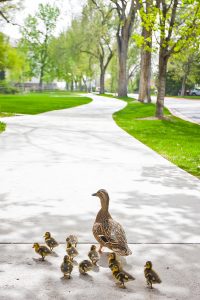
Two ducks huddle under the shade of a tree as construction crews clamor past, setting the groundwork for the new BYU engineering building.
Construction is an almost endless scene on the BYU campus. This continuous commotion is teaching BYU’s domesticated wildlife what it takes to live in an urbanized ecosystem.
“It’s just a natural consequence of urbanization,” said BYU biology professor Byron Adams. “As we spread and sprawl and encroach on wild lands we are going to have to expect to have more and more encounters with wildlife. And in a lot of ways, it’s cool.”
BYU is not blind to the effect that its construction has on the ecosystem. “It’s a very managed ecosystem. They build knowing they are going to make a disturbance,” Adams said.
These disturbances will have various levels of impact on the wildlife. The ducks and plants are the ones that will be most affected. However; for the deer, construction on campus won’t be too much of a hassle. Deer are primarily nocturnal and most of the work will occur during the day, leaving little complications between the two.
However, as history shows, construction at BYU is not always harmless. When building the new Life Science Building, BYU accidentally killed off “the centennial tree,” a beautiful Sequoia donated by a class of students. According to Adams, its death was unnecessary and occurred simply because of neglect.
“Sometimes it’s tricky because the systems are so complicated that whenever we think we are taking the necessary precautions, something bad can still happen,” said BYU environmental science graduate Ian Blackwelder.
While there is no official policy concerning the handling of wildlife on campus, BYU has made careful plans to manage the effects of the construction in an enclosed space. This will help limit the amount of negative consequences on other parts of campus, such as the duck pond.
“Anytime you disturb your landscape … you generally kill most of what’s there,” said Larry St. Clair, the director of the Bean Life Science Museum. BYU, however, is working to prevent this. Administrators have an idea for how they want campus to look and a plan to achieve that vision. However, even this does not guarantee 100 percent safety for the ducks.
“It’s hard to say don’t do anything unless we know all the facts because I don’t think we will ever know all the facts,” Blackwelder said. “So I think it’s just proceed with caution and with an awareness of potential harmful effects. Just be ready to say we are causing significant harm in this area, we should stop doing this and be willing to stop.”
Campus projects are increasingly friendly to the environment. Both the new Life Science and engineering building will be LEED certified and energy efficient. “It’s better now than it was,” Adams said.
BYU officials are not the only ones that need to look out for ducks. Students also have an important role in protecting the ecosystem during construction. “Taking care of it, appreciating it, studying it, thinking about it are all remarkable things you can do to not only improve it, but better enjoy it,“ St. Clair said.
Adams agrees.
“The most important things students can do is understand our ecosystems on campus and learn about them, appreciate them and then own them,” Adams said. According to Adams, students should take responsibility to explore and look after the campus’ special landscape.
“Often we think as humans we live in our world and the animals live in their world, but we share the same world, and we share the same campus,” Blackwelder said. “The world is our campus, but our campus is their world.”




